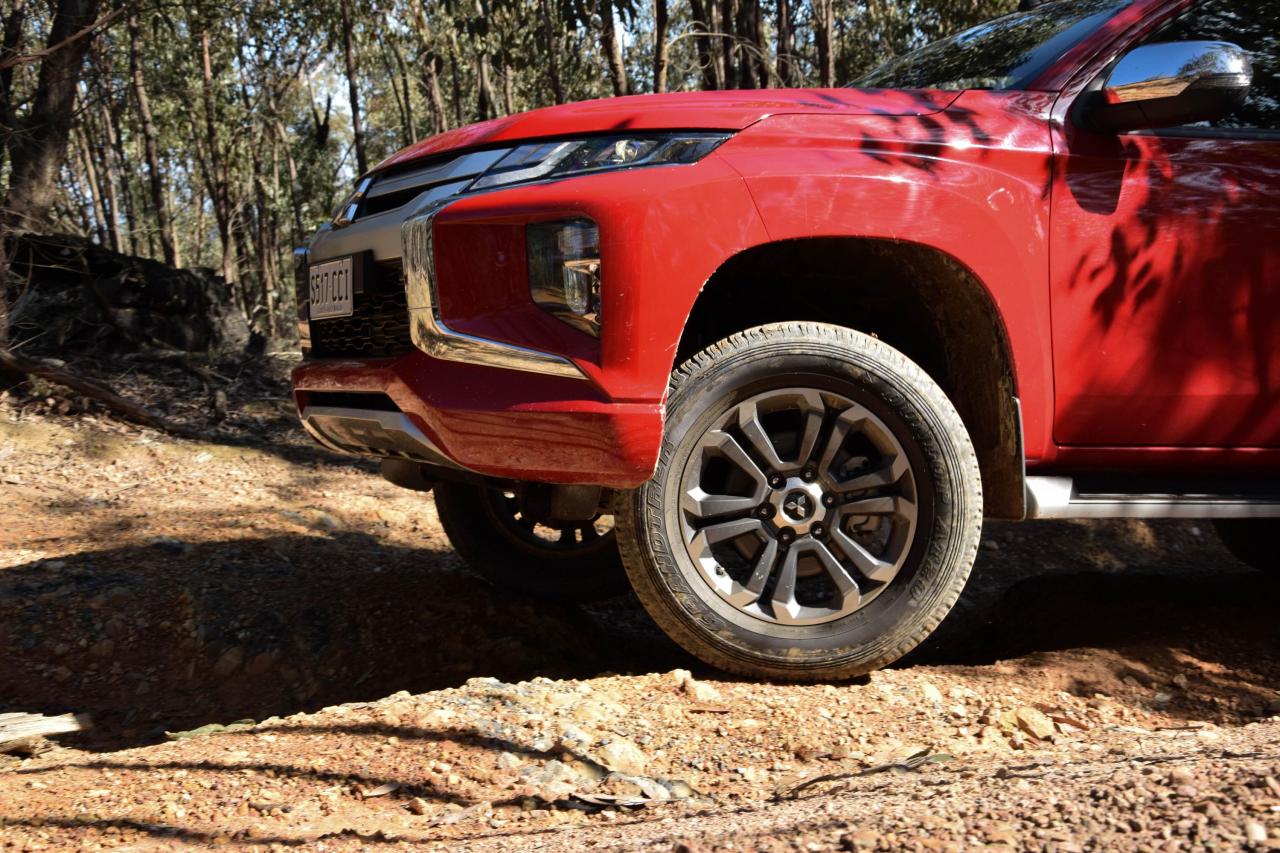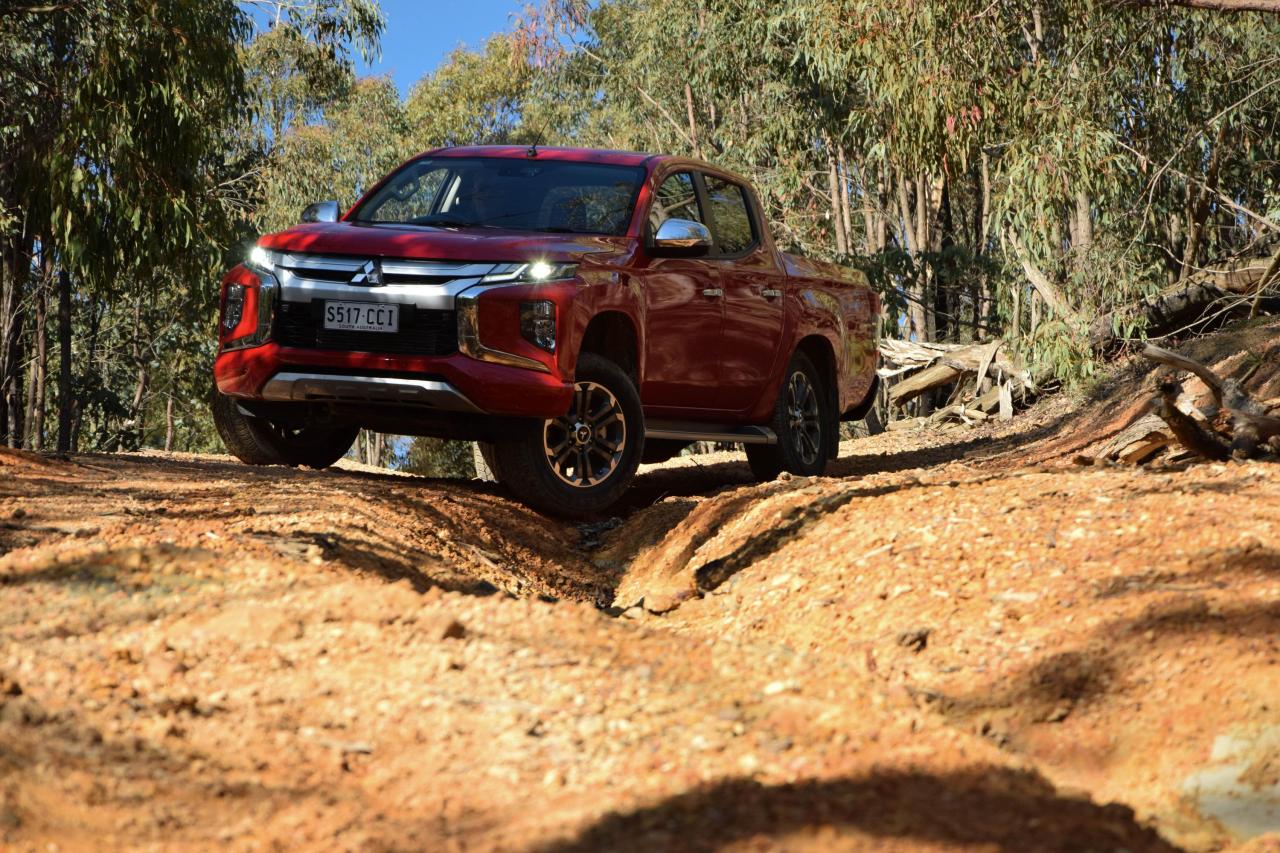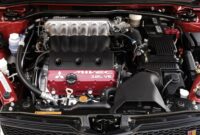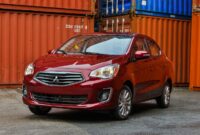Mitsubishi Triton off-road capability comparison with competitors: The rugged landscape awaits. This deep dive explores how the Mitsubishi Triton stacks up against its toughest rivals in the off-road pickup truck arena. We’ll dissect its engine specs, suspension, and tech features, comparing them head-to-head with leading contenders to see if the Triton truly reigns supreme when the pavement ends.
Get ready for a muddy, thrilling ride!
From its humble beginnings to its current iteration, the Triton has carved a niche for itself. This isn’t just about horsepower and ground clearance; it’s about understanding the nuances of off-road performance – the subtle differences that separate a capable truck from a true champion. We’ll analyze real-world scenarios, scrutinize user experiences, and leave no stone unturned in our quest to crown the ultimate off-road king.
Introduction
The Mitsubishi Triton, a stalwart in the pickup truck segment, boasts a robust reputation for its off-road capabilities. This isn’t just hype; it’s built on a legacy of rugged engineering and continuous improvement across its generations. From its humble beginnings, the Triton has evolved into a serious contender in the competitive off-road market, offering a compelling blend of performance, durability, and practicality.The Triton’s off-road prowess stems from its typically available features like a powerful engine (variations exist depending on the model year and trim level), a robust ladder frame chassis, a sophisticated four-wheel-drive system with various selectable modes (often including low-range gearing), and substantial ground clearance.
These elements, combined with often-available features like electronic traction control and hill descent control, provide drivers with the confidence to tackle challenging terrains.
Triton’s Off-Road Lineage
The Mitsubishi Triton’s history is deeply rooted in the development of capable off-road vehicles. While the specific name and design have evolved over the years, the underlying philosophy of rugged durability and all-terrain performance has remained consistent. Each generation has seen improvements in engine power, suspension systems, and four-wheel-drive technology, reflecting advancements in automotive engineering and a continuous effort to enhance off-road capabilities.
This commitment to improvement is evident in the Triton’s enduring popularity among off-road enthusiasts and professionals who rely on a vehicle’s capability to handle demanding environments.
Triton’s Target Market and Segment Positioning
The Mitsubishi Triton targets a diverse market, encompassing both recreational off-roaders and professionals who depend on a reliable workhorse. It appeals to individuals and businesses needing a vehicle capable of handling demanding tasks, from towing heavy loads to traversing rough terrain. Within the off-road vehicle segment, the Triton occupies a competitive space, offering a compelling value proposition that balances capability with affordability compared to some more specialized or luxury off-road vehicles.
Its strong reputation for reliability and durability further strengthens its position in this demanding market.
Triton’s Off-Road Specifications and Features
The Mitsubishi Triton’s off-road prowess isn’t just hype; it’s backed by solid engineering and a range of features designed to conquer challenging terrains. Let’s delve into the specifics of what makes this pickup a serious contender in the off-road arena.
Engine and Transmission Specifications
The Triton offers a variety of engine and transmission options, each impacting its off-road capabilities differently. Powerful engines provide the torque necessary for climbing steep inclines and navigating through challenging obstacles, while the transmission plays a crucial role in managing that power effectively. For example, a robust 4×4 system coupled with a low-range gearbox significantly enhances traction and control in low-grip situations.
Different engine options, such as diesel and petrol, offer varying power outputs and fuel efficiencies, influencing overall off-road performance and range. The availability of automatic and manual transmissions caters to different driver preferences and driving styles, further affecting the off-road experience.
Suspension, Ground Clearance, and Angles
The Triton’s suspension system is engineered to absorb impacts and maintain stability on uneven surfaces. Its design, incorporating features like independent front suspension and a robust rear setup, contributes to a comfortable ride even on rough terrain. High ground clearance allows the Triton to navigate over obstacles without scraping the undercarriage, a critical factor in off-road driving. The approach and departure angles, which measure the steepest incline the vehicle can climb or descend without bottoming out, are also crucial indicators of off-road capability.
Larger angles translate to a greater ability to tackle steep inclines and descents.
Triton Trim Level Comparison
The following table compares different Triton trim levels and their off-road specifications. Note that specific features and specifications may vary depending on the region and year of manufacture. Always consult your local Mitsubishi dealer for the most accurate and up-to-date information.
| Trim Level | Engine | Ground Clearance (mm) | 4×4 System |
|---|---|---|---|
| GLX | 2.4L MIVEC Diesel | 205 | Part-time 4WD |
| GLS | 2.4L MIVEC Diesel | 205 | Part-time 4WD |
| Adventure | 2.4L MIVEC Diesel | 220 | Super Select 4WD-II |
| Ultimate | 2.4L MIVEC Diesel | 220 | Super Select 4WD-II |
Competitor Analysis: Mitsubishi Triton Off-road Capability Comparison With Competitors
The Mitsubishi Triton faces stiff competition in the off-road pickup truck segment. Several models offer compelling features and capabilities, making a direct comparison crucial for potential buyers. This analysis will focus on key rivals, highlighting their strengths and weaknesses in comparison to the Triton. Understanding these differences helps clarify the Triton’s unique position in the market.
Key Competitors in the Off-Road Pickup Truck Segment, Mitsubishi Triton off-road capability comparison with competitors
Several manufacturers offer strong competitors to the Mitsubishi Triton in the rugged off-road pickup truck market. These vehicles are chosen based on their popularity, market share, and comparable features and capabilities. The following list details the key rivals and their off-road prowess.
- Toyota Hilux: A long-standing and highly reputable player, the Toyota Hilux boasts legendary reliability and a robust off-road pedigree. Its reputation for durability and its availability of various configurations, including high-riding variants with advanced off-road technologies, make it a significant competitor. Many versions offer features like selectable 4WD systems, locking differentials, and advanced traction control.
- Ford Ranger: The Ford Ranger offers a powerful engine lineup and a well-regarded off-road package, particularly in its higher trim levels. Features such as Terrain Management System, allowing for various driving modes optimized for different terrains, and advanced off-road suspension contribute to its off-road capability. Its strong towing capacity is another key selling point.
- Isuzu D-Max: Known for its rugged build and competitive pricing, the Isuzu D-Max is a solid contender. While perhaps not as technologically advanced as some competitors, its robust construction and simple, reliable mechanics make it a dependable choice for off-road adventures. It often comes standard with features suitable for light to moderate off-road use.
- Nissan Navara: The Nissan Navara provides a blend of comfort and capability. Depending on the trim level, it offers features such as a sophisticated all-wheel-drive system, hill descent control, and various off-road driving modes. It focuses on a balance between on-road comfort and off-road capability.
Comparative Analysis

Let’s dive into the nitty-gritty of how the Mitsubishi Triton stacks up against its key competitors in the off-road arena. We’ll be looking at hard numbers to see where the Triton excels and where it might fall slightly short. Remember, the “best” truck depends heavily on your specific needs and priorities.
This comparative analysis focuses on key off-road performance metrics, allowing for a direct comparison of the Mitsubishi Triton’s capabilities against its rivals. By examining these figures, we can gain a clearer understanding of each vehicle’s strengths and weaknesses in various off-road scenarios.
Off-Road Performance Metrics Comparison
The following table directly compares the Mitsubishi Triton with its main competitors across several crucial off-road metrics. Note that specific figures can vary slightly depending on the trim level and year of the vehicle. These values represent averages based on readily available manufacturer specifications.
| Vehicle | Ground Clearance (mm) | Approach Angle (degrees) | Departure Angle (degrees) | Wading Depth (mm) | Towing Capacity (kg) |
|---|---|---|---|---|---|
| Mitsubishi Triton | 220-235 (depending on trim) | 30-31 | 22-23 | 700 | 3100-3500 (depending on trim and market) |
| Toyota Hilux | 210-230 (depending on trim) | 29-31 | 26-28 | 700 | 3500 |
| Ford Ranger | 237 | 28 | 25 | 800 | 3500 |
| Isuzu D-Max | 235 | 30 | 25 | 800 | 3500 |
Analyzing the table, we can see that the Triton generally holds its own against the competition. While the Ford Ranger and Isuzu D-Max boast slightly higher wading depths, the Triton offers competitive ground clearance, approach, and departure angles. Its towing capacity is also in line with, or surpasses, some competitors depending on the specific Triton trim level. The Toyota Hilux, a long-standing competitor, offers comparable performance across most metrics.
While the Mitsubishi Triton’s off-road prowess is often compared to rivals like the Ford Ranger and Toyota Hilux, it’s interesting to consider the brand’s broader reliability. For instance, understanding potential issues like those found in the Mitsubishi Eclipse Cross engine problems and solutions gives a wider perspective on Mitsubishi’s engineering. This knowledge helps contextualize the Triton’s overall build quality when assessing its long-term off-road capability against competitors.
The Triton’s advantage lies in its balance of capabilities. It doesn’t necessarily excel in any single metric, but provides a well-rounded package suitable for a variety of off-road situations. For instance, its decent ground clearance is crucial for navigating rough terrain, while the approach and departure angles are vital for tackling steep inclines and descents. The towing capacity is significant for those needing to haul heavy loads.
However, a potential disadvantage could be its slightly lower wading depth compared to the Ford Ranger and Isuzu D-Max in some trim levels. This might limit its capabilities in extremely flooded conditions. This difference however, might be negligible for most users.
Technological Features Comparison

The Mitsubishi Triton’s off-road prowess isn’t solely defined by its robust build; advanced technology plays a crucial role in conquering challenging terrains. This section delves into a comparison of the key off-road technologies offered by the Triton and its main competitors, highlighting their functionalities and effectiveness in real-world scenarios. We’ll analyze how these features translate to a superior off-road experience.
Off-Road Technology Overview
Several technological features significantly enhance a vehicle’s off-road capabilities. These features often work in conjunction to provide superior traction, control, and stability on uneven surfaces. Key technologies include traction control systems, hill descent control (HDC), differential locks (front, rear, or center), and advanced driver-assistance systems (ADAS) with off-road-specific functionalities. The effectiveness of these systems varies based on their design, implementation, and integration with other vehicle systems.
Triton’s Technological Arsenal
The Mitsubishi Triton boasts a comprehensive suite of off-road technologies designed to maximize its capabilities. Its Super Select 4WD-II system, for example, offers multiple driving modes tailored to different terrains, allowing drivers to select the optimal setting for maximum traction and control. This system, combined with features like Hill Descent Control (HDC) and Active Stability Control (ASC), provides confidence-inspiring performance even on steep inclines and slippery surfaces.
Want to know how the Mitsubishi Triton stacks up against its rivals in off-road prowess? Consider factors like ground clearance and approach angles. But beyond the ruggedness of the Triton, long-term reliability is key, and that’s where checking out reviews like these Mitsubishi Outlander PHEV long term reliability reviews can offer insights into Mitsubishi’s overall build quality, influencing your perception of the Triton’s potential durability.
Ultimately, a comprehensive off-road capability comparison needs to consider the bigger picture of the brand’s reliability.
The availability of a rear differential lock further enhances traction in low-grip situations, allowing the Triton to navigate challenging obstacles with ease.
Competitor Technology Comparison
To accurately assess the Triton’s technological standing, we’ll compare its key off-road features against its primary competitors. This comparative analysis will focus on the presence and capabilities of traction control, hill descent control, and differential locks. The level of sophistication and effectiveness of these systems can vary significantly between manufacturers and models, impacting the overall off-road experience.
| Vehicle | Traction Control | Hill Descent Control | Rear Differential Lock | Front Differential Lock | Center Differential Lock |
|---|---|---|---|---|---|
| Mitsubishi Triton | Yes | Yes | Yes (optional on some trims) | No | No |
| Toyota Hilux | Yes | Yes | Yes (optional on some trims) | No | No |
| Ford Ranger | Yes | Yes | Yes (optional on some trims) | No | No |
| Isuzu D-Max | Yes | Yes | Yes (optional on some trims) | No | No |
| Nissan Navara | Yes | Yes | Yes (optional on some trims) | No | No |
Real-World Performance and User Experiences
Moving beyond the specifications and technical details, let’s delve into the real-world performance and user experiences reported for the Mitsubishi Triton and its key competitors when tackling various off-road challenges. Understanding how these vehicles perform in diverse conditions offers a crucial perspective beyond the manufacturer’s claims. This section will examine real-world scenarios and user feedback to provide a more holistic view of each vehicle’s off-road capabilities.
Off-Road Performance Across Different Terrains
The following examples illustrate how the Triton and its competitors handle various off-road terrains. User reviews and anecdotal evidence highlight strengths and weaknesses, providing valuable insights for potential buyers.
- Mitsubishi Triton: Users consistently praise the Triton’s performance on muddy trails and rocky ascents. Many report successfully navigating challenging inclines and maintaining traction even in slippery conditions. However, some users have noted limitations in deep sand, requiring careful maneuvering and sometimes assistance. One user described effortlessly climbing a steep, rocky mountain path, while another mentioned struggling with deep, loose sand that required multiple attempts and a change in driving technique.
- Toyota Hilux: Known for its robust build and reliability, the Hilux often receives positive feedback for its ability to handle challenging terrains. Users frequently cite its dependability in harsh conditions, particularly in rocky and mountainous areas. However, some reports suggest its turning radius might be a limitation on tighter trails. One user highlighted its impressive performance navigating a rocky riverbed, while another pointed out the difficulties encountered when trying to maneuver the vehicle on a narrow, winding mountain road.
- Ford Ranger: The Ford Ranger is often lauded for its comfortable ride and powerful engine, which translate to a capable off-road experience for many users. Reports suggest good performance on gravel roads and moderate off-road trails. However, some users have expressed concerns about ground clearance in more challenging, rocky environments. One user described a comfortable and capable experience on a gravel road, while another noted the need for caution when navigating rocky sections due to the vehicle’s lower ground clearance.
Limitations and Challenges Encountered
While each vehicle possesses impressive off-road capabilities, certain limitations and challenges have been reported by users. These limitations often depend on the specific terrain and driving conditions.
- Ground Clearance Issues: Several users reported difficulties with ground clearance, particularly on vehicles with lower suspension setups. This resulted in scraping the undercarriage on rocks and uneven terrain, highlighting the importance of considering ground clearance when selecting a vehicle for off-road use.
- Tyre Selection: The choice of tires significantly impacts off-road performance. Users who opted for all-terrain tires reported improved traction compared to those using standard road tires. This emphasizes the importance of selecting appropriate tires based on the anticipated off-road conditions.
- Engine Power and Torque: In challenging situations such as steep inclines or deep mud, engine power and torque play a crucial role. Users of vehicles with less powerful engines reported struggling in these situations, highlighting the importance of considering engine specifications when choosing an off-road vehicle.
Visual Comparison
A visual inspection reveals key differences in design elements contributing to each vehicle’s off-road prowess. The interplay of suspension, tire size, ground clearance, and overall body structure significantly impacts a vehicle’s ability to tackle challenging terrains. Let’s examine these visual cues across the Mitsubishi Triton and its competitors.
Tire Size and Ground Clearance
Tire size directly influences traction and ground clearance, a crucial aspect of off-road capability. Larger diameter tires provide better grip on uneven surfaces and increase the vehicle’s ability to clear obstacles. Visually, the Triton’s tire size can be compared to its competitors; for instance, a larger tire diameter on the Triton compared to a competitor would immediately indicate a potential advantage in traversing rough terrain.
A higher ground clearance, visually apparent as the distance between the lowest point of the vehicle’s undercarriage and the ground, further enhances the vehicle’s ability to navigate obstacles without scraping the bottom. The visual difference in ride height between the Triton and, say, a Ford Ranger, would be readily apparent, with a higher ride height suggesting better off-road performance.
Suspension Design
Suspension systems play a critical role in maintaining wheel contact with the ground, even on uneven surfaces. Different suspension designs offer varying levels of articulation and travel. Visually, a Triton with a robust suspension system might exhibit longer travel shocks and a more substantial-looking suspension setup compared to competitors. For example, a competitor’s suspension might appear less robust, indicating a potential compromise in off-road performance.
This visual difference would be highlighted by the presence of features such as long-travel shocks, which visually demonstrate greater suspension articulation.
Body Structure and Approach/Departure Angles
The overall body structure, specifically the approach and departure angles, significantly impacts off-road capability. A short front overhang (approach angle) and a short rear overhang (departure angle) allow the vehicle to climb and descend steep inclines more easily without bottoming out. Visually, the Triton’s shorter overhangs compared to competitors would be noticeable, suggesting a superior ability to tackle challenging inclines.
A competitor with a longer wheelbase and a more pronounced front overhang might visibly struggle in comparison when negotiating steep inclines. The visual difference in these angles is crucial in assessing the vehicle’s ability to traverse rocky terrain or steep slopes.


